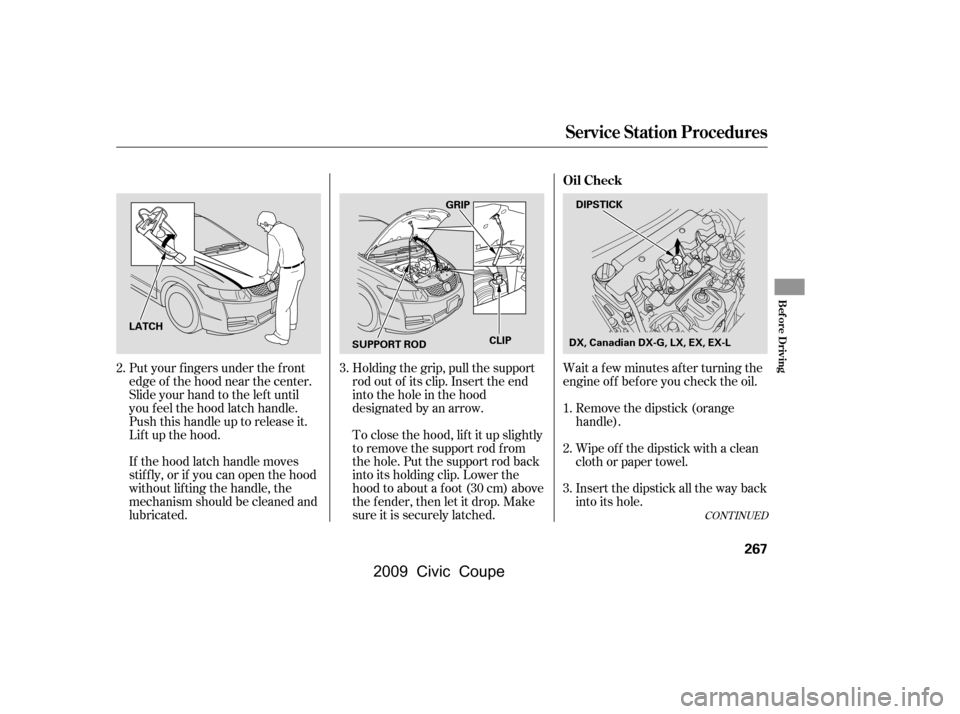Page 71 of 412

This shows how much f uel you have.
It may show slightly more or less
than the actual amount.This shows the temperature of the
engine’s coolant. During normal
operation, the reading should rise to
about the middle of the gauge. In
severe driving conditions, such as
very hot weather or a long period of
uphill driving, the reading may rise
intotheupperhalfofthegauge.Ifit
reaches the red (Hot) mark, pull
safely to the side of the road. See
page f or instructions and
precautions on checking the engine
cooling system.Your vehicle’s onboard diagnostic
system will detect a loose or missing
f uel f ill cap as an evaporative system
leak. The f irst time a leak is detected
a ‘‘CHECK FUEL CAP’’ message
appears on the information display.
Turn the engine of f , and conf irm the
f uel f ill cap is installed. If it is, loosen
it, then retighten it until it clicks at
least once. The message should go
off after several days of normal
driving once you tighten or replace
the f uel f ill cap. To scroll to another
display, press the SEL/RESET
button. The ‘‘CHECK FUEL CAP’’
message will appear each time you
restart the engine until the system
turns the message of f .
359
Fuel Gauge T emperature Gauge Check Fuel Cap Message
Gauges
68
Avoid driving with an extremely low
f uel level. Running out of f uel could
cause the engine to misf ire, damaging
the catalytic converter.
�\f���—�\f���—�\f���y�
�\f���������
�y���
�(�+�������\f�y�\f�\f�����y
2009 Civic Coupe
Page 72 of 412
The inf ormation display in the
instrument panel shows you the
engine oil lif e and maintenance
service items when the ignition
switch is in the ON (II) position. This
inf ormation helps to keep you aware
of the periodic maintenance your
vehicle needs f or continued trouble-
f ree driving. Ref er to page f or
more inf ormation.
If the system still detects a leak in
your vehicle’s evaporative emissions
system, the malf unction indicator
lamp (MIL) comes on. If the f uel f ill
cap was not already tightened, turn
the engine of f , and check or
retighten the f uel f ill cap until it
clicks at least once. The MIL should
go off after several days of normal
driving once the cap is tightened or
replaced. If the MIL does not go of f ,
have your vehicle inspected by a
dealer. For more inf ormation, see
page .
362 303
Maintenance Minder
Gauges
Inst rument s and Cont rols
69
�\f���—�\f���—�\f���y�
�\f�����������y���
�(�+�������\f�y�\f�\f�����y
2009 Civic Coupe
Page 106 of 412

�µIf your vehicle’s battery is
disconnected or goes dead, or the
driver’s window f use is removed, the
AUTO f unction could be disabled. If
the power window system needs to
be reset af ter reconnecting the
battery or installing the f use, do this:
Start the engine. Push down and
hold the driver’s window switch
until the window is f ully open.
Pull and hold the driver’s window
switch to close the window
completely, then hold the switch
f or about 2 seconds.
If the power windows do not operate
properly af ter resetting, have your
vehicle checked by your dealer.
When you push the MAIN switch in,
the switch is OFF, and the
passenger’s window cannot be raised
or lowered. To cancel this f eature,
push on the switch again to get it to
pop out. Keep the MAIN switch off
whenyouhavechildreninthe
vehicle so they do not injure
themselves by operating the window
unintentionally.
If the driver’s
window runs into any obstacle while
it is closing automatically, it will
reverse direction, and then stop. To
close the window, remove the
obstacle, then use the window switch
again.
Auto reverse stops sensing when the
window is almost closed. You should
always check that all passengers and
objects are away from the window
bef ore closing it.
Only on the driver’s window,
the auto reverse f unction is disabled
when you continuously pull up the
switch.
Thewindowsoperateforupto10
minutes after you turn off the
ignition switch. Opening either door
cancels this f unction. 1.
2.
Except DX and Canadian DX-G
All models
Power Windows
AUTO REVERSE
Inst rument s and Cont rols
103
NOTE:
�\f���—�\f���—�\f���y�
������
��
���y���
�(�+�������\f�y�\f�
�\f���y
2009 Civic Coupe
Page 266 of 412
Bef ore you begin driving your
vehicle, you should know what
gasoline to use and how to check the
levels of important f luids. You also
need to know how to properly store
luggage or packages. The
inf ormation in this section will help
you. If you plan to add any
accessories to your vehicle, please
read the information in this section
first..............................
Break-in Period .264
.................
Fuel Recommendation .264
.........
Service Station Procedures .265
....................................
Ref ueling .265
Opening and Closing
................................
the Hood .266
...................................
Oil Check .267
.............
Engine Coolant Check .269
...............................
Fuel Economy .270
...
Accessories and Modif ications .273
.............................
Carrying Cargo .275
Bef ore Driving
Bef ore Driving
263
�\f���—�\f���—�\f���y�
�
����\f��\f���y���
�(�+�������\f�y�\f�������y
2009 Civic Coupe
Page 270 of 412

Wait a f ew minutes af ter turning the
engine of f bef ore you check the oil.
Put your f ingers under the f ront
edge of the hood near the center.
Slide your hand to the lef t until
you f eel the hood latch handle.
Push this handle up to release it.
Lif t up the hood.
If the hood latch handle moves
stif f ly, or if you can open the hood
without lifting the handle, the
mechanism should be cleaned and
lubricated. To close the hood, lif t it up slightly
to remove the support rod f rom
the hole. Put the support rod back
into its holding clip. Lower the
hood to about a f oot (30 cm) above
the fender, then let it drop. Make
sure it is securely latched.Remove the dipstick (orange
handle).
Wipe of f the dipstick with a clean
cloth or paper towel.
Insert the dipstick all the way back
into its hole.
Holding the grip, pull the support
rod out of its clip. Insert the end
into the hole in the hood
designated by an arrow.
3.
1.
2.
3.
2.
CONT INUED
Service Station Procedures
Oil Check
Bef ore Driving
267
DIPSTICK
LATCH SUPPORT RODDX, Canadian DX-G, LX, EX, EX-L
CLIP
GRIP
�\f���—�\f���—�\f���y�
�
����\f������y���
�(�+�������\f�y�\f�������y
2009 Civic Coupe
Page 271 of 412
Remove the dipstick again, and
check the level. It should be
between the upper and lower
marks.If it is near or below the lower mark,
see on page .
4.
312
Service Station Procedures
A dding Engine Oil
268
Si
Si UPPER MARK
LOWER MARK
DX, Canadian DX-G, LX, EX, EX-L LOWER MARK
UPPER MARK
DIPSTICK
�\f���—�\f���—�\f���y�
�
����\f����\f�y���
�(�+�������\f�y�\f�������y
2009 Civic Coupe
Page 272 of 412
Look at the coolant level in the
radiator reserve tank. Make sure it is
between the MAX and MIN lines. If
it is below the MIN line, seeon page f or
inf ormation on adding the proper
coolant. Refer to
on page f or inf ormation
about checking other items on your
vehicle.
316 308
A dding
Engine Coolant Owner’s Maintenance
Checks
Engine Coolant Check
Service Station Procedures
Bef ore Driving
269
RESERVE TANK
SiRESERVE TANK
MAX
MIN
MAX
MIN
DX, Canadian DX-G, LX, EX, EX-L
�\f���—�\f���—�\f���y�
�
����\f������y���
�(�+�������\f�y�\f�������y
2009 Civic Coupe
Page 274 of 412

�µ�µ
�µ �µ
�µ
�µ�µ
Aggressive driving (hard
acceleration and braking)
Excessive idling, accelerating and
braking in stop-and-go traf f ic
Cold engine operation (engines
aremoreefficientwhenwarmed
up)
Driving with a heavy load or the
air conditioner running
Improperly inf lated tires
The f ollowing f actors can lower your
vehicle’s f uel economy:
A properly maintained vehicle
maximizes f uel economy. Poor
maintenance can signif icantly reduce
f uel economy. Always maintain your
vehicle according to the maintenance
messages displayed on the
inf ormation display (see
on page ).
For example: Rapid
acceleration, abrupt cornering,
and hard braking increase fuel
consumption.
Aerodynamic drag has a big ef f ect
on f uel mileage at speeds above 45
mph (75 km/h). Reduce your
speed and you reduce the drag.
Trailers, car top carriers, roof
racks and bike racks are also big
contributors to increased drag.
If your vehicle has a
manual transmission, you can
boost your f uel economy by up
shif ting as early as possible.
Idling
results in 0 miles per gallon.
An underinf lated tire increases
‘‘rolling resistance,’’ which reduces
f uel economy.
It puts a heavier
load on the engine, increasing f uel
consumption.
In
particular, a build-up of snow or
mud on your vehicle’s underside
adds weight and rolling resistance.
Frequent cleaning helps your f uel
economy.
308
CONT INUED
Fuel Economy
Fuel Economy Factors Use the recommended viscosity motor oil, displaying the A PI
Certif ication Seal (see page
).
Improving Fuel Economy Owner’s
Maintenance Checks Drive moderately
Observe the speed limit
Always drive in the highest gear
possible
Avoid excessive idling
Maintain proper tire inf lation
A void carrying excess weight in
your vehicle
K eep your vehicle clean
312
Vehicle Maint enance Drive Ef f icient ly
Bef ore Driving
271
�\f���—�\f���—�\f���y�
�
����
��
���y���
�(�+�������\f�y�\f�������y
2009 Civic Coupe